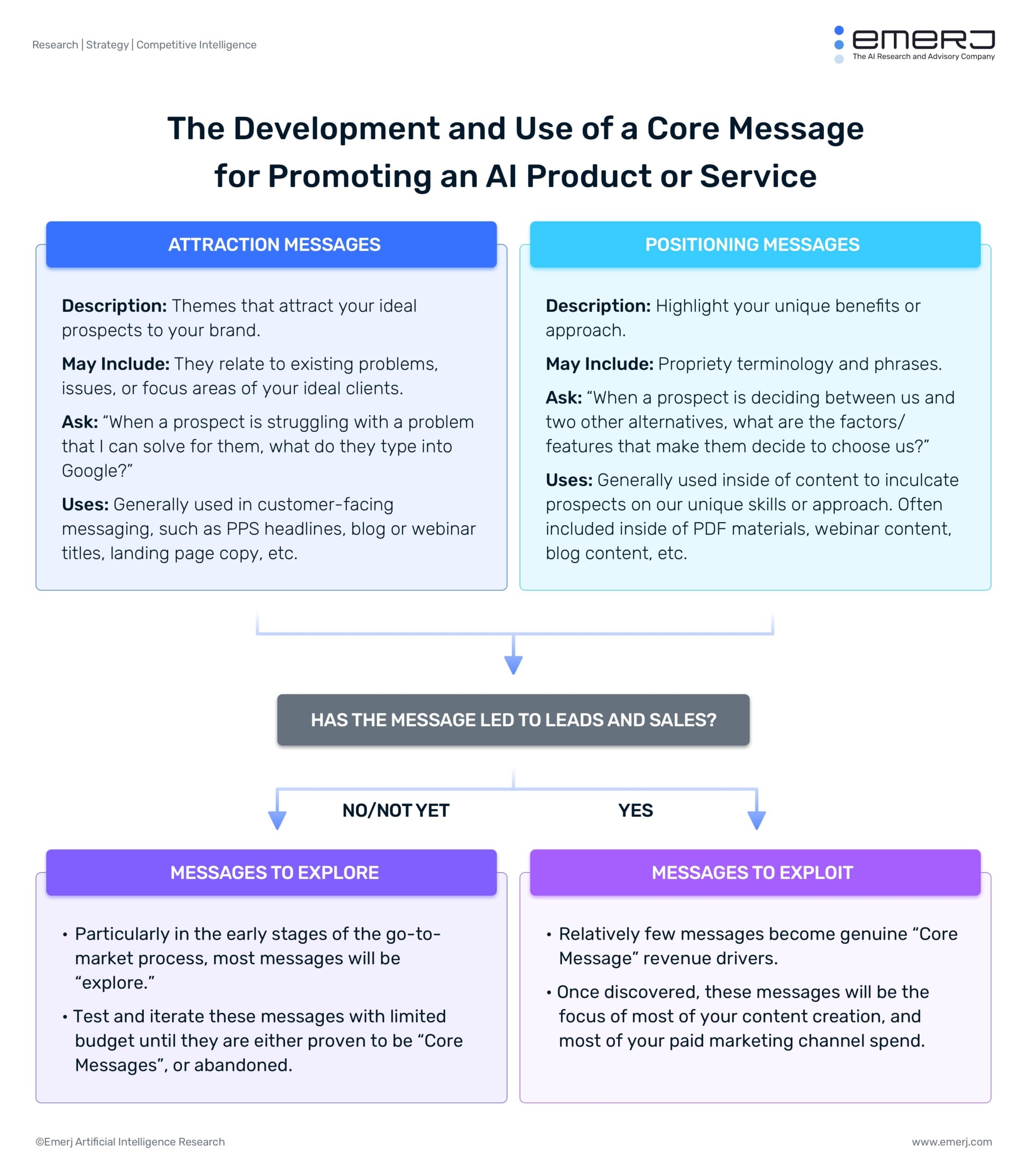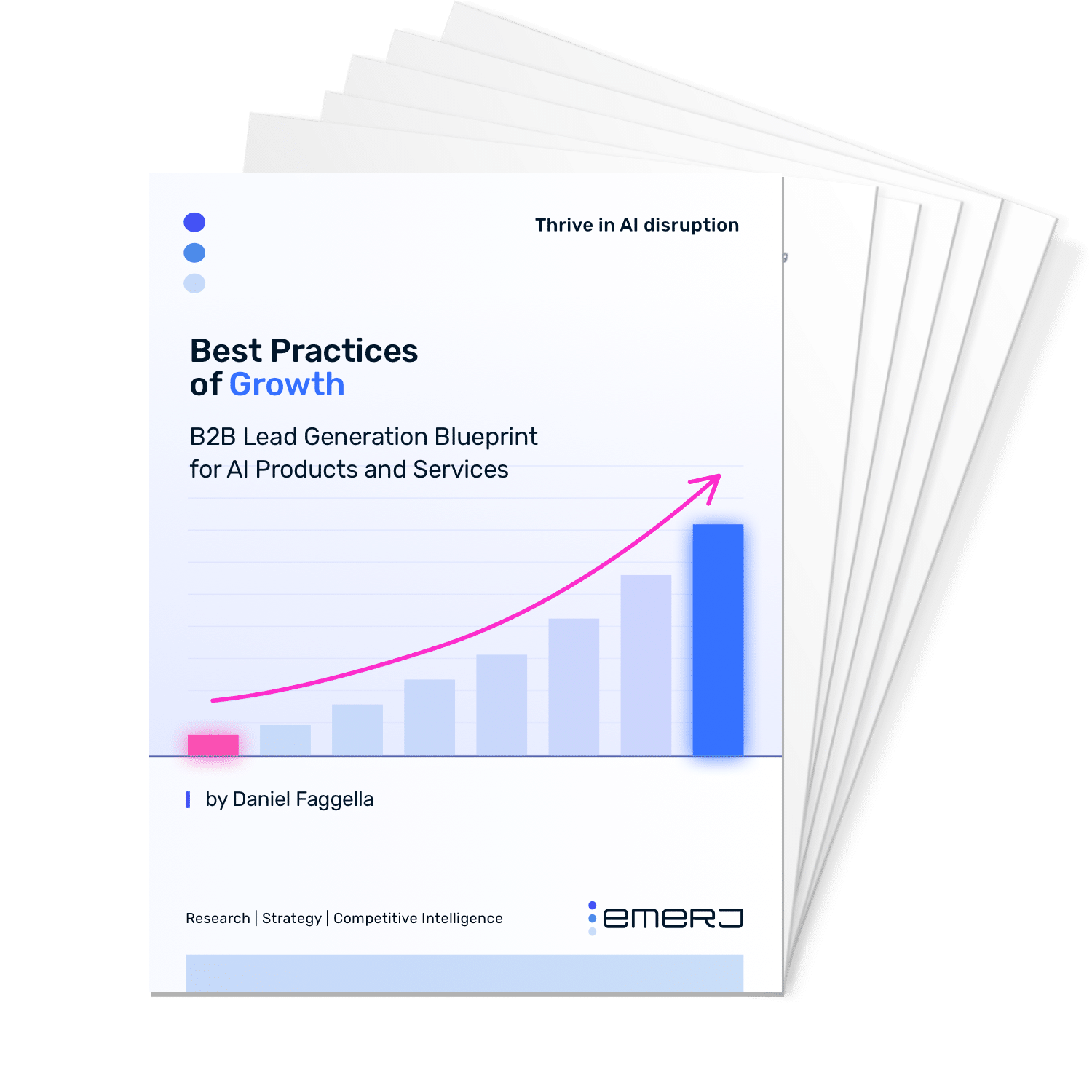Over the last three years, Emerj has had the privilege to work on hundreds of individual thought leadership and lead generation campaigns for AI companies around the world – via our Creative Services arm.
Working hand-in-hand with marketing leaders has given us tremendous insight into what some of the smartest AI marketers in the industry are doing today – and it’s also helped us to better understand the common pitfalls of marketing AI products and services.
One of the factors that distinguish successful and unsuccessful AI marketers is the clarity of the market message.
In this article, we’ll draw a clear distinction between “attraction” and “positioning” messages, and provide a framework of how to use both productively. We’ll also explore our concept of a “core message” and how they can be discovered and leveraged to improve the results of your marketing.
If you sell AI products or services (including consulting), this article will give you a clear path to simplify your market message and better allocate marketing spend.
If you’re an enterprise leader and potential buyer of AI services, the details in this article will help you get a better sense of which vendors have more traction (and consequently, a better, tighter sense of their value proposition in the market), and which don’t.
We’ll start by exploring the difference between “attraction” and “positioning” themes.
Attention or Positioning-Oriented Topics and Themes
Content marketing efforts for a B2B AI company can be divided into two categories:
1. “Attraction” Topics and Themes.
These are actively being searched for and clicked on by prospects. These are hot-button terms – or are at least already understood – by your target audience.
Examples:
- Healthcare executives already know what it means to “improve appointment scheduling,” and they may search for or click this topic if it is of interest.
- Fraud prevention leaders at a bank are already aware of the term “anti-money laundering (AML),” and none of them have any misconceptions about what this term broadly implies.
These topics and themes are best used as the “meat” of SEO content – especially for article titles and or page headlines.
2. “Positioning” Topics and Themes
These are not actively being searched for and clicked on by prospects. These are proprietary terms or slogans that you want your company to be known for, something to use to position your business or product in a unique way.
Examples:
- A healthcare vendor who refers to their solution with the invented term: “Appointment intelligence”
- A banking fraud prevention vendor who describes their process as “Reversing the fraud workflow”
These terms are highly unlikely to be searched online, and they are less likely to grab attention or get clicks in online ads because prospects are unlikely to know what they mean.
While we may want to create content that ranks for our own unique phrases, buzzwords, and mottos, this is not going to be the content that attracts most of your prospects. Instead of using these topics as the base of SEO content efforts, these topics can be woven into said content. AI firms often rely too heavily on their own proprietary terms and buzzwords – while they should be placing the bulk of their attention (and certainly their market-facing messaging) on discrete and specific attraction-related themes.
Instead, positioning topics and terms are often best used in sales collateral or specific landing pages to be used with specific stakeholder groups. This material can be used selectively to carve out a position in the market. The positioning-oriented themes are ideas that the company believes to be differentiators.
Explore and Exploit – The Development of a “Core Message”
Exploring messages – and experimenting with “attraction” and “positioning” messaging, should eventually result in the discovery of what we call a “core message” – a message that reliably generates leads (interest potential prospects) and sales (paying customers). The graphic below summarizes our process outline for finding a core message – and in the remainder of this article, we’ll walk you through the process of what this message discovery involves.

We can think of market messages as having two parts.
Who: Who we’re targeting. The specific kind of prospect (an individual human being) we’re targeting, segmented by:
- Industry
- Title/role
- Geography
- Company size
- Etc…
What: What we want to be known for. The specific problem we solve, or the opportunities or capabilities that we unlock, which might include:
- A specific workflow challenge that our service overcomes
- A legal risk that we help clients reduce
- A market advantage that we provide to clients
- Etc…
Let’s explore some examples here:
An AI-enabled search and discovery platform might appeal to compliance VPs and directors in banking with the following messages:
- “We help banking compliance leaders uncover non-compliant legal contracts with a simple search tool – without expensive and lengthy manual review processes.”
- “We reduce risk for enterprise banking compliance leaders by quickly surfacing non-compliant messages between brokers and clients, or procurement and vendors.”
- Etc…
These message address one who with a variety of what messages, but we might expand the exercise to a variety of who targets as well.
Note that the “what” message can on some occasions include a bit of positioning-oriented themes or topics, but will almost always be attention-oriented. Market-facing messages must resonate with themes that are already of pressing concern for the prospects.
You can imagine a similar exercise for your own firm – exploring the who and what variants, and developing a portfolio of go-to-market messages.
The goal, of course, is to go beyond experimentation and to find messages we can consistently use to win sales.
B2B marketing leaders should think about all of their attention-oriented who and what messages in two categories:
Explore messages: These market messages (combinations of who and what) are hypothesized to be worth exploring. It hasn’t been squarely proven useful or useless.
A company can never “explore” an infinite number of messages, and must prioritize which messages to go to market with. Smart marketing teams check-in regularly with these explore messages and determine which have proven valuable (delivering leads and sales), and which are almost certainly not resonating.
Exploit messages: These market messages (combinations of who and what) have proven useful to generate leads and sales in a reliable way.
It often takes months or even years of “explore” messages to find a single “exploit” message. Diligent, deliberate market testing and interactions with the market is the only way to speed up this process – and it’s especially the case with emerging technology like AI. Many AI firms never reach the point of finding an “exploit” message at all.
Note that firms may develop a suite of core messages for different buyer personas and different markets. The more broad and multi-faceted the vendor solution is, the more likely that they’ll develop many core messages over time. Even in the case with these open-ended solutions, however, core messages are hard-won, and finding three or four such messages within a single year is probably an unreasonable goal.
Firms with longer sales cycles may have a harder time finding these messages, as a successful message (i.e. one that delivers sales) will take a longer time to confirm.
When messages fail to resonate, they can be adjusted and explored further, or dropped entirely to be replaced by new message combinations.
When core messages (i.e. messages that consistently attract leads that turn into sales) emerge, they’re exploited in thought leadership and content – which is the focus of our next sections.
Examples and Proper Use of “Attraction” and “Positioning” Messages

We can illustrate the difference between these two ideas with the following example:
Example Company: An AI-enabled document search and discovery company for the banking industry.
Attention-Oriented Themes and Topics:
“Reduce regulatory risk with 360-degree customer search, find any/all documents related to a specific customer and become GDPR compliant.”
“Assess legal risk by quickly searching legal documents for specific clauses, terms, or language.”
Positioning-Oriented Themes and Topics:
“Develop a broad search ontology to create related clusters of documents, allowing users to find commonly searched items together.”
“Combine OCR with an enterprise document platform that allows any user to find files (scanned images, text documents, invoices, etc) from anywhere.”
Different themes and topics belong in different places in our campaigns, and their purposes vary.
Attention-oriented topics and themes are generally best used as:
- Article headlines
- Podcast titles
- PDF white paper titles
- Webinar titles
Positioning-oriented topics and themes are generally best used as:
- Middle or bottom-of-funnel content
- The topics and themes weaved into the inside of your content (webinar presentation, PDF white paper, blog post)
For example, a company offering a broad computer vision analytics platform might want to be known for its unique approach to vision data, and its unique combination of proprietary algorithms. The company may even have a special name of its proprietary menagerie of algorithms and workflows – a unique term that they use to stand out. This is positioning-oriented, not attention-oriented.
The company will likely want to attract customers by appealing to specific computer vision problems (i.e. identifying X in satellite imagery), or specific outcomes (i.e. avoiding manufacturing errors by visually detection them automatically).
They may create top-of-funnel content around general topics such as “how to solve business problems with computer vision,” but even this broad theme – which prospects may be searching for online, doesn’t necessarily have anything to do with the proprietary mix of algorithms that the company emphasizes in it’s positioning-oriented messages.
The messaging that faces the market should be attention-oriented, and should eventually result in a strong, proven message that consistently gets leads and sales.
Achieving Narrow “Attraction” Themes for AI Products – Difficult but Necessary
Many AI products and services can hypothetically be used in an endless number of ways.
For example:
- A recommendation engine might be used to recommend email subject lines, or content in an app’s feed, or products in a specific section of an online store.
- An enterprise search and discovery solution might be used to identify legal risks, or find information about clients, to search internal FAQs, to serve related content to customers in a customer service portal, and so on.
- Etc…
Companies cannot go to market with a message that implies that their solution is all things to all people. A bundle of abstract, hard-to-articulate capabilities is not a message likely to win leads and deals. Companies must focus on specific pieces of their value proposition that can hit hard – specific combinations of who and what, not a broad list of the thousand things their product might help with.
An AI-powered search and discovery firm might create white papers and articles with titles (attention-oriented) that appeal to reducing legal risk for life sciences compliance leaders, and the inside of those articles and white papers might also frankly state some of the other, broader AI capabilities that can be unlocked (positioning-oriented).
It’s important to know your true differentiators, and the full range of your capabilities (which are nearly always positioning-oriented topics and themes), but it’s also important to develop the discipline to explore specific, market-facing messages that are targeted and specific enough to get attention, without necessarily being so overtly specific as to limit your brand’s reputation for a wider range of capabilities.
Only with this exploration of specific messages can we find what we refer to as a “core message.”
AI Brands Grow with Emerj
With millions of global readers per year and millions of podcast downloads – Emerj reaches influential enterprise leaders across industries. Reach a global AI audience and leverage Emerj’s expertise in crafting powerful AI content for the C-suite.
From podcasts, to email sponsorship, to white papers and beyond – establish your thought leadership – learn more about Emerj Creative Services.














